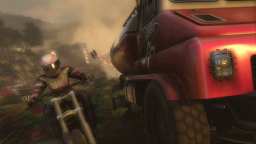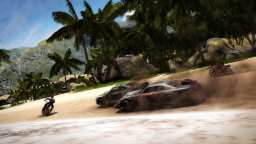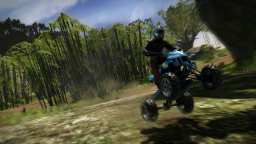| |
 MotorStorm:
Pacific Rift (Playstation 3) MotorStorm:
Pacific Rift (Playstation 3)
Sony's Motorstorm franchise returns in fine
form with the arrival of Pacific Rift on PS3. It delivers a more expansive
and deeper racing experience with more varied racing environments and
elaborate track layouts. There's also expanded online play and a new
vehicle class, Monster trucks. The sense of chaos remains and helps
Pacific Rift builds on the successful formula of the first game. Most of
the play action is similar, with a similar boost system used to propel
players forward, while avoiding obstacles. New elements this time include
volcanic lava rivers and deep mud pits that you must avoid or face instant
death. The game's structure has been expanded with a new style-based
ranking system that takes into account how you perform. This is a solid
sequel that delivers the intense, action-packed racing fans have come to
expect from the series. |
While the PS3 launch title MotorStorm won a
lot of plaudits from gamers for its intense, chaotic racing action and
breathtaking visual design, some elements of the game weren't as polished
as they could have been. One of the biggest problems in the first game was
its desert setting that while impressively detailed and rendered, began to
look the same after awhile. This problem has been addressed in the new
installment, Pacific Rift. The developers have changed the setting to an
abandoned tropical island which immediately makes for a more colorful and
varied series of environments. Players will race along beaches, dense
jungles thick with vegetation, through rivers, waterfalls mud flats,
mountainous peaks and through volcanic ashes, each of which offers unique
challenges to the player. Each level gives off a much more distinctive
feel this time around, which helps to make Pacific Rift feel like a much
deeper game. While the game's basic controls and play largely stay true to
the first title, there are loads of options that extend it's replay value
significantly. The basic objective is to cross the finish line before your
opponents by whatever means you can. As in the first game, you have a
nitro boost that you can use to give you added speed. It can be used at
anytime, but don't overdo it, since you can easily cause your vehicle to
overheat and explode if you aren't careful. You also need to avoid
crashing into objects, falling off the sides of massive jumps while
keeping an eye out for your opponents, who take great pleasure in knocking
you off the track. It's a fairly simple and straightforward game on that
level, but since the first title was immediately appealing to many gamers,
you really can't fault SCEA's developers at Evolution Studios for staying
faithful to what worked the first time.
 Players
can choose to play a single race through one of the courses, which is fun
but doesn't unlock anything. In order to do that, you'll need to compete
in multiple races in the Festival mode. These are grouped in several basic
types of race zones - Fire, Air, Water and Earth. Each of these settings
offers a unique challenge in terms of obstacles and environments. As you
compete in these races, and earn medals you'll earn tickets that you can
use to unlock additional tracks and courses in each section. This sound
simple enough, but some areas can't be unlocked unless you have access to
a specific vehicle class, which can only be used once you earn medals in
the special Motorstorm events. There are a total of 16 unique courses in
the game, but there are numerous races on each with different parameters
to complete. Most of the game is fairly easy to unlock, though it takes
time and patience. It's slightly more complex this time around, but the
game's structure is still quite straightforward this time around. If you
don't want to compete in a long series of races, you can also create
custom race tickets where you can choose the course, vehicle class and
number of races. As you win vehicles, they'll be added to your garage, and
you can customize their skins and paint jobs and give them a closer look
in this mode as well. Pacific Rift also includes extensive online support
for up to 16 players simultaneously, split screen mode that supports up to
three players along with other community features such as leader boards
and trophies which add to the sense of immersion. Players
can choose to play a single race through one of the courses, which is fun
but doesn't unlock anything. In order to do that, you'll need to compete
in multiple races in the Festival mode. These are grouped in several basic
types of race zones - Fire, Air, Water and Earth. Each of these settings
offers a unique challenge in terms of obstacles and environments. As you
compete in these races, and earn medals you'll earn tickets that you can
use to unlock additional tracks and courses in each section. This sound
simple enough, but some areas can't be unlocked unless you have access to
a specific vehicle class, which can only be used once you earn medals in
the special Motorstorm events. There are a total of 16 unique courses in
the game, but there are numerous races on each with different parameters
to complete. Most of the game is fairly easy to unlock, though it takes
time and patience. It's slightly more complex this time around, but the
game's structure is still quite straightforward this time around. If you
don't want to compete in a long series of races, you can also create
custom race tickets where you can choose the course, vehicle class and
number of races. As you win vehicles, they'll be added to your garage, and
you can customize their skins and paint jobs and give them a closer look
in this mode as well. Pacific Rift also includes extensive online support
for up to 16 players simultaneously, split screen mode that supports up to
three players along with other community features such as leader boards
and trophies which add to the sense of immersion.
Before you begin each race, you can
choose from one of several different vehicles to race, and your selection
is important because Pacific Rift's multiple paths are geared for these
specific vehicle types. There are seven unique vehicle types in the game
including Buggies, Bikes, ATVs, Trucks, Big Rigs, Mudpluggers and this
edition's big addition, Monster Trucks. Each vehicle class offers unique
play in terms of handling, speed, acceleration, damage and more. Learning
how to race with them effectively, and on which tracks is a key element to
succeeding in the game. If you use the wrong vehicle type or choose the
wrong path, you'll find yourself helplessly behind the pack. However, the
tracks this time around seem a little shorter, which makes it less painful
and it's a bit easier to catch up after minor mistakes as well. This makes
for a more rounded title that should be slightly easier for casual racing
fans to play. While the damage model is superficial in terms of
performance which doesn't degrade after impact, the loss of time when you
crash multiple times can make a big difference. It's fairly easy to find
the best path, since the numerous signs usually point you in the right
direction. Failing that, you can race behind the pack for the first lap or
so and find a fast route by watching where your opponents drive. It also
pays to learn the location of obstacles and dangerous sections at first,
so you aren't caught off guard, which can happen frequently if you're
unfamiliar with the track layout.
Once you get on the track, you'll find
that the courses are more imaginative with numerous short cuts, massive
jumps, huge gaps and multiple paths through each, which makes the racing
feel much more visceral and keeps your interest level high much longer.
For example, you can choose to take a higher route over a dense forest
packed with dangerous trees and rocks, but the narrow ramps and huge gaps
reduce your margin for error, making both paths equally difficult. As in
the last game, the best path depends on which vehicle you choose, the
heavy trucks aren't as nimble as smaller vehicles and their weight makes
it harder for them to navigate the narrower sections of track. Conversely,
the smaller vehicles are usually faster and more flexible, but they're not
as stable, making them more difficult to control, which causes crashes to
occur much more frequently. This gives Pacific Rift's vehicles a lot of
balance and makes them feel like they're more evenly matched. The AI is
smarter this time around with more aggressive opponent vehicles that will
battle you relentlessly. In shades of the classic Road Rash series,
players can now extend their arms out of the motorcycles or buggies to try
and push their rivals off the track. It seems like a minor addition, but
it adds to the rebellious spirit of MotorStorm. While it definitely
retains the gameplay of the first game, there are some significant
improvements this time around that make for a more visually impressive
experience.
 The
basic approach is immediately familiar, but the new desert island setting
allows for a much broader array of environments and locations. This
increased diversity is complimented by an improved graphics engine that
offers much greater polish in terms of presentation and action. The island
location allows for a variety of new environmental effects such as water
and fire to make for a dramatically improved experience overall. Pacific
Rift's jungle environments are dense with plants and trees, causing a
slightly claustrophobic feel in certain sections which makes the open
areas all the more impressive. There are massive ramps and jumps placed
throughout each level and these leaps can be quite breathtaking. However,
if you take them the wrong way, you'll cause a spectacular crash, which
stops the action so it can be viewed in slow motion. You can watch as your
driver is flung around the level while the shrapnel of their wrecked
vehicle twists and turns around them. It's an impressive effect that's
been carried through from the first game successfully and makes crashing
quite an impressive event. MotorStorm: Pacific Rift's graphics engine is
quite impressive and runs at a consistent frame rate, making for some
brutally intense racing action that unfolds at a relentless pace. It's
hard-rock soundtrack adds to game's sense of anarchic glee, and
compliments its brutal racing effectively. This is a spectacular looking
racing title and improves its visual punch from the first game
significantly, making it a good showcase of the PS3's power. The
basic approach is immediately familiar, but the new desert island setting
allows for a much broader array of environments and locations. This
increased diversity is complimented by an improved graphics engine that
offers much greater polish in terms of presentation and action. The island
location allows for a variety of new environmental effects such as water
and fire to make for a dramatically improved experience overall. Pacific
Rift's jungle environments are dense with plants and trees, causing a
slightly claustrophobic feel in certain sections which makes the open
areas all the more impressive. There are massive ramps and jumps placed
throughout each level and these leaps can be quite breathtaking. However,
if you take them the wrong way, you'll cause a spectacular crash, which
stops the action so it can be viewed in slow motion. You can watch as your
driver is flung around the level while the shrapnel of their wrecked
vehicle twists and turns around them. It's an impressive effect that's
been carried through from the first game successfully and makes crashing
quite an impressive event. MotorStorm: Pacific Rift's graphics engine is
quite impressive and runs at a consistent frame rate, making for some
brutally intense racing action that unfolds at a relentless pace. It's
hard-rock soundtrack adds to game's sense of anarchic glee, and
compliments its brutal racing effectively. This is a spectacular looking
racing title and improves its visual punch from the first game
significantly, making it a good showcase of the PS3's power.
Gamers looking for a simulation or even
any sense of realism are going to be disappointed, but the arcade-style
physics and controls make Motorstom: Pacific Rift an excellent title that
should please those looking for a quick adrenaline rush. It's open-ended
structure makes progression easy, which creates an instantly enjoyable,
but also deeply engaging game that allows you to go deeper and unlock
numerous extras. The diverse tracks mark a big improvement from the first
title, giving the races added punch. An increased number of hazards and
traps makes the game less predictable, along with the AI which has been
improved to make your opponents harder to predict. As an added bonus, dual
shock support has been included, no download patches need. This makes for
a solidly entertaining follow-up with enough changes and additions to
please players who enjoyed the first game. Motorstorm: Pacific Rift is a
solidly entertaining, deep yet accessible racing title that delivers an
exciting experience for fans of action packed racing. - Michael Palisano
|
| |
|

